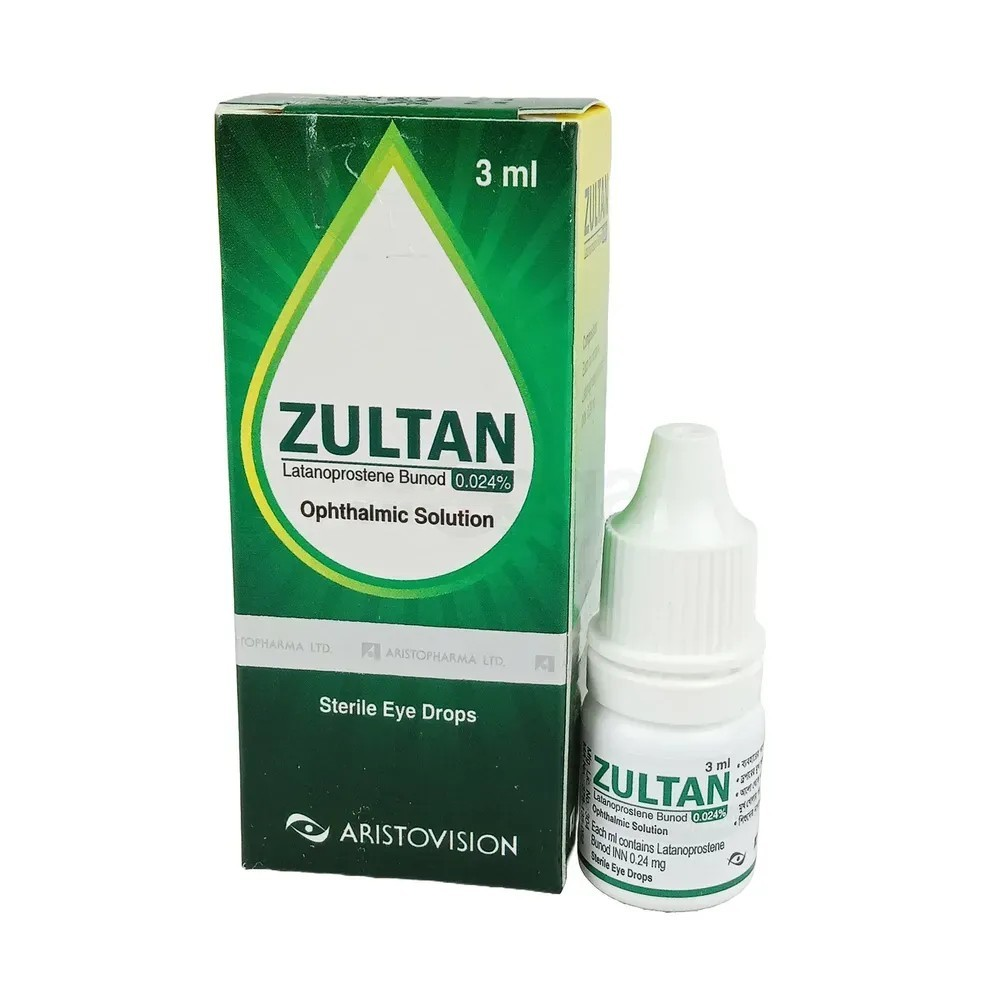3 ml drop:
৳ 800.00
Indications
Zultan 0.024% ophthalmic solution is indicated for the reduction of intraocular pressure (IOP) in patients with open-angle glaucoma or ocular hypertension.
Pharmacology
Latanoprostene bunod is thought to lower intraocular pressure by increasing outflow of aqueous humor through both the trabecular meshwork and uveoscleral routes. Intraocular pressure is a major modifiable risk factor for glaucoma progression. Reduction of intraocular pressure reduces risk of glaucomatous visual field loss.
Dosage & Administration
The recommended dosage is one drop in the conjunctival sac of the affected eye(s) once daily in the evening. Do not administer Latanoprostene Bunod ophthalmic solution, 0.024% more than once daily since it has been shown that more frequent administration of prostaglandin analogs may lessen the intraocular pressure lowering effect. If Latanoprostene Bunod is to be used concomitantly with other topical ophthalmic drug products to lower intraocular pressure, administer each drug product at least five (5) minutes apart.
Contraindications
Latanoprostene Bunod eye drops are contraindicated in patients who are hypersensitive to any component of this preparation.
Side Effects
The following adverse reactions are described elsewhere in the labeling:
- Pigmentation
- Eyelash Changes
- Intraocular Inflammation
- Macular Edema
- Bacterial Keratitis
- Use with Contact Lens
Pregnancy & Lactation
There are no available human data for the use of Latanoprostene Bunod during pregnancy to inform any drug associated risks. There are no data on the presence of Latanoprostene Bunod in human milk, the effects on the breastfed infant, or the effects on milk production. The developmental and health benefits of breastfeeding should be considered, along with the mother’s clinical need for Latanoprostene Bunod, and any potential adverse effects on the breastfed infant from Latanoprostene Bunod.
Precautions & Warnings
Pigmentation: Zultan ophthalmic solution, 0.024% may cause changes to pigmented tissues. The most frequently reported changes with prostaglandin analogs have been increased pigmentation of the iris and periorbital tissue (eyelid). Pigmentation is expected to increase as long as Zultan ophthalmic solution is administered. The pigmentation change is due to increased melanin content in the melanocytes rather than to an increase in the number of melanocytes. After discontinuation of Zultan, pigmentation of the iris is likely to be permanent, while pigmentation of the periorbital tissue and eyelash changes are likely to be reversible in most patients. Patients who receive prostaglandin analogs, including Zultan, should be informed of the possibility of increased pigmentation, including permanent changes. The long-term effects of increased pigmentation are not known. Iris color change may not be noticeable for several months to years. Typically, the brown pigmentation around the pupil spreads concentrically towards the periphery of the iris and the entire iris or parts of the iris become more brownish. Neither nevi nor freckles of the iris appear to be affected by treatment. While treatment with Zultan (Zultan ophthalmic solution), 0.024% can be continued in patients who develop noticeably increased iris pigmentation, these patients should be examined regularly.
Eyelash Changes: Zultan may gradually change eyelashes and vellus hair in the treated eye. These changes include increased length, thickness, and the number of lashes or hairs. Eyelash changes are usually reversible upon discontinuation of treatment.
Intraocular Inflammation: Zultan should be used with caution in patients with a history of intraocular inflammation (iritis/uveitis) and should generally not be used in patients with active intraocular inflammation as it may exacerbate this condition.
Macular Edema: Macular edema, including cystoid macular edema, has been reported during treatment with prostaglandin analogs. Zultan should be used with caution in aphakic patients, in pseudophakic patients with a torn posterior lens capsule, or in patients with known risk factors for macular edema.
Bacterial Keratitis: There have been reports of bacterial keratitis associated with the use of multiple-dose containers of topical ophthalmic products. These containers had been inadvertently contaminated by patients who, in most cases, had a concurrent corneal disease or a disruption of the ocular epithelial surface.
Use with Contact Lens: Contact lenses should be removed prior to the administration of Zultan because Zultan contains benzalkonium chloride. Lenses may be reinserted 15 minutes after administration.
Eyelash Changes: Zultan may gradually change eyelashes and vellus hair in the treated eye. These changes include increased length, thickness, and the number of lashes or hairs. Eyelash changes are usually reversible upon discontinuation of treatment.
Intraocular Inflammation: Zultan should be used with caution in patients with a history of intraocular inflammation (iritis/uveitis) and should generally not be used in patients with active intraocular inflammation as it may exacerbate this condition.
Macular Edema: Macular edema, including cystoid macular edema, has been reported during treatment with prostaglandin analogs. Zultan should be used with caution in aphakic patients, in pseudophakic patients with a torn posterior lens capsule, or in patients with known risk factors for macular edema.
Bacterial Keratitis: There have been reports of bacterial keratitis associated with the use of multiple-dose containers of topical ophthalmic products. These containers had been inadvertently contaminated by patients who, in most cases, had a concurrent corneal disease or a disruption of the ocular epithelial surface.
Use with Contact Lens: Contact lenses should be removed prior to the administration of Zultan because Zultan contains benzalkonium chloride. Lenses may be reinserted 15 minutes after administration.
Use in Special Populations
Pediatric Use: Use in pediatric patients aged 16 years and younger is not recommended because of potential safety concerns related to increased pigmentation following long-term chronic use.
Geriatric Use: No overall clinical differences in safety or effectiveness have been observed between elderly and other adult patients.
Geriatric Use: No overall clinical differences in safety or effectiveness have been observed between elderly and other adult patients.
Storage Conditions
Unopened bottle should be stored refrigerated at 2° to 8°C. Once a bottle is opened it may be stored at 2° to 25°C for 8 weeks.


